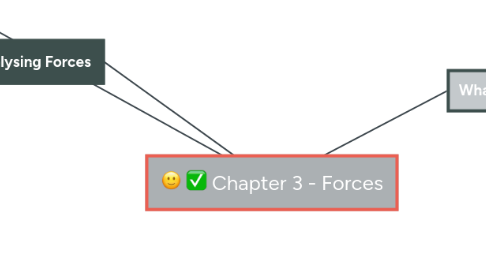
1. Analysing "Cause and Effect" in Forces
2. Analysing Forces
2.1. Analysing Parallel Forces
2.1.1. 1. Assign a positive direction
2.1.2. 2. Represent each force as a vector arrow
2.1.3. 3. Sum the Vectors
2.2. Analysing non-parallel Forces
2.2.1. Parallelogram method
2.2.1.1. 1. Assign a suitable scale
2.2.1.2. 2. Draw both forces using the same scale "TAIL TO TAIL"
2.2.1.3. 3. Complete the other half of the parallelogram using compass or protractor
2.2.1.4. 4. Draw a straight line from the tails to the opposite corner of the parallelogram with a double arrow head
2.2.2. Tip to Tail Method
2.2.2.1. 1. Assign a suitable scale
2.2.2.1.1. 5. Measure the length of the double headed arrow (Resultant Force) and the angle from any chosen reference point
2.2.2.2. 2. Draw both forces using the same scale "TIP TO TAIL"
2.2.2.3. 3. Connect the "tail" of the first vector to the "tip" of the last vector"
2.2.2.4. 4. Measure the length of the double headed arrow (Resultant Force) and the angle from any chosen reference point
2.2.2.5. NOTE: If all vectors (without resultant) form a closed triangle, the forces are in equilibrium
3. What is a Force?
3.1. It is a push or a pull
3.2. It can be contact or non contact
3.2.1. contact
3.2.1.1. Friction
3.2.1.1.1. Friction is a force that opposes motion
3.2.1.1.2. Friction is proportonal to the normal contact force at the face of contact
3.2.1.1.3. Friction can be useful
3.2.1.1.4. lubrication
3.2.1.1.5. Friction can be a nuisance
3.2.1.1.6. Friction can be reduced by
3.2.2. non-contact
3.2.2.1. Magnetic Force
3.2.2.2. Gravitational Force
3.2.2.3. Electric Force
